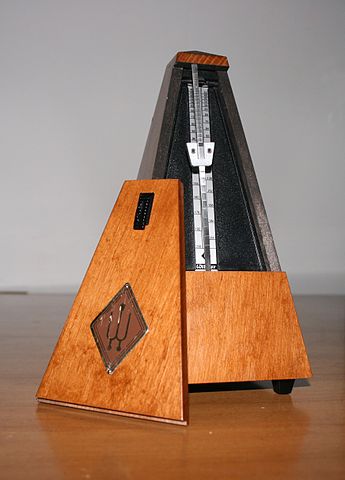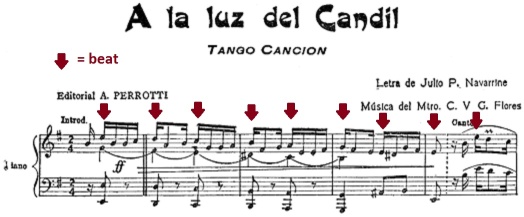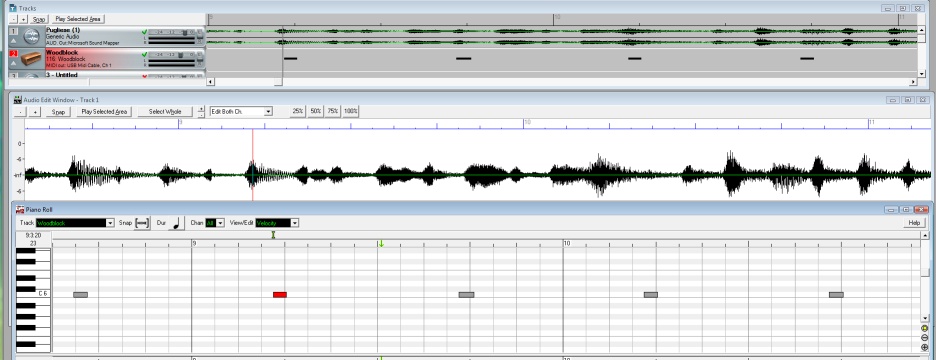
Differences Exposed - in the Light of an Oil Lamp
Carlos Di Sarli and Osvaldo Pugliese belong to the big names of the Golden Era of tango. Both acting on the melodic side of the style spectrum – as opposed to D’Arienzo, Troilo or Tanturi (et al.) on the rhythmic side – they developed their distinctive styles that differ from each other in many respects, not least in articulation and accentuation. This time, however, I will concentrate on the temporal aspect of music, i.e. tempo and handling of beat. Dance music is almost invariably based on recurring beat, and so is also danceable tango.
One thing that indicates that Di Sarli and Pugliese might have different stylistic approaches is that their repertoires don’t overlap for more than just a few tangos. However, I wanted to compare two performances of a single piece so that the differences would come from the interpretations, not the music itself, and was lucky to find an extremely dramatic tango that ideally suits our theme. It is A la luz del candil (In the Light of an Oil Lamp), composed by Carlos V. G. Flores in 1927. The lyrics by Julio Navarrine tell a grim story: A gaucho confesses a double homicide to a police officer. I suggest you listen now the recordings by Carlos Di Sarli & Jorge Durán (1956) and Osvaldo Pugliese & Miguel Montero (1954). Don’t believe the titling of the Di Sarli video – the singer is Jorge Durán, a baritone, not Mario Pomar, a tenor.
Tempo Made Visual
By tempo we mean the speed or pace of music in beats per unit of time. We can determine the average tempo of a piece simply by taking a stopwatch and counting the beats during one minute (bpm). When tango is concerned, we are counting the basic beat, i.e. quarter notes, like this:

But tempo might not be constant throughout a performance. In classical music and in many styles of popular song, variations in tempo are used as a means of expression. We speak of tempo rubato when the performer “steals time” to or from a note or a passage. To determine the beat-by-beat tempo, we should measure the time between two beats and take the inverse.
I recorded MIDI sequences by tapping the keyboard while listening to these two performances of A la luz del candil. In some cases I had to align the MIDI note events manually with the perceived beat in music taking advance of the wave graph of the audio recording. Then I computed a series of beat-by-beat tempos from the MIDI timings and made a tempo graph from both of the performances.

Let’s first have a look at the graph of Di Sarli’s performance:

The average tempo is about 56 bpm, and there is not much variation in tempo before the final ritardando. The slight fluctuation might be due to errors in determining the beats, or they might reflect an actual musical phenomenon – this question definitely deserves further investigation some other time. Anyhow, the perceived beat, when listening to the music, is constant and accurate, ticking like a clockwork or metronome. There is, however, some tempo rubato, but it always happens in the melody (voice or violins) against and not affecting the beat.
Pugliese’s graph looks quite different:

Tempo changes are outstanding, and from time to time there is no tempo at all! The gaps in the graph were caused by the fact that at certain passages I could not find any kind of beat – the notes just followed each other in a free flow like in traditional chanting or opera recitative, and when there is no beat, there is no tempo. Given the premise that tempo rubato is a means of expression, it is easy to agree that there is a whole lot of expression in Pugliese’s playing.
Although Pugliese’s treatment of tempo is more dramatic, Di Sarli’s performance is by no means void of drama, either. He has the full scale of dynamics at his disposal, which he also uses, and the dramatic baritone voice of Jorge Durán paints the gloomy story in rich colors.
Di Sarli and Pugliese on the Dance Floor
It is a well-known fact that there hardly is a tango class where Di Sarli won’t be played, but Pugliese is seldom heard, at least at elementary to intermediate level classes. In milongas one might hear several tandas of Di Sarli one evening, but Pugliese has always been something you only should play well after midnight when less experienced dancers have already withdrawn from the battle field.
Considering our findings about tempo, it is quite clear why dancers find it easy and safe to dance to Di Sarli, thanks to the regular beat that never pulls the rug from under your feet. With Pugliese, you will really have to listen to the music and find the beat when there is one. When there is no beat, you should calm down, take a closer embrace with your partner and concentrate on small and slow movements or adornments. When the beat is back again and gets passionate, you would express it with powerful walking, whooshing sacadas or whatever rhythmic you might find appropriate. That’s art!
On the average one could characterize Di Sarli’s music as cool and Pugliese’s as passionate knowing that this is not the whole truth. Another point of view we might find interesting is that history records tell us how Pugliese mainly played at places favored by the working class where boleos, ganchos and other daring figures were often seen, whereas Di Sarli’s audience was more high society dancing in a more restrained manner.
Anyway, both Carlos Di Sarli and Osvaldo Pugliese have a permanent place in our hearts as tango lovers. Although a bit different, their music represents the very core of Golden Age tango and the melodic tendency within it.